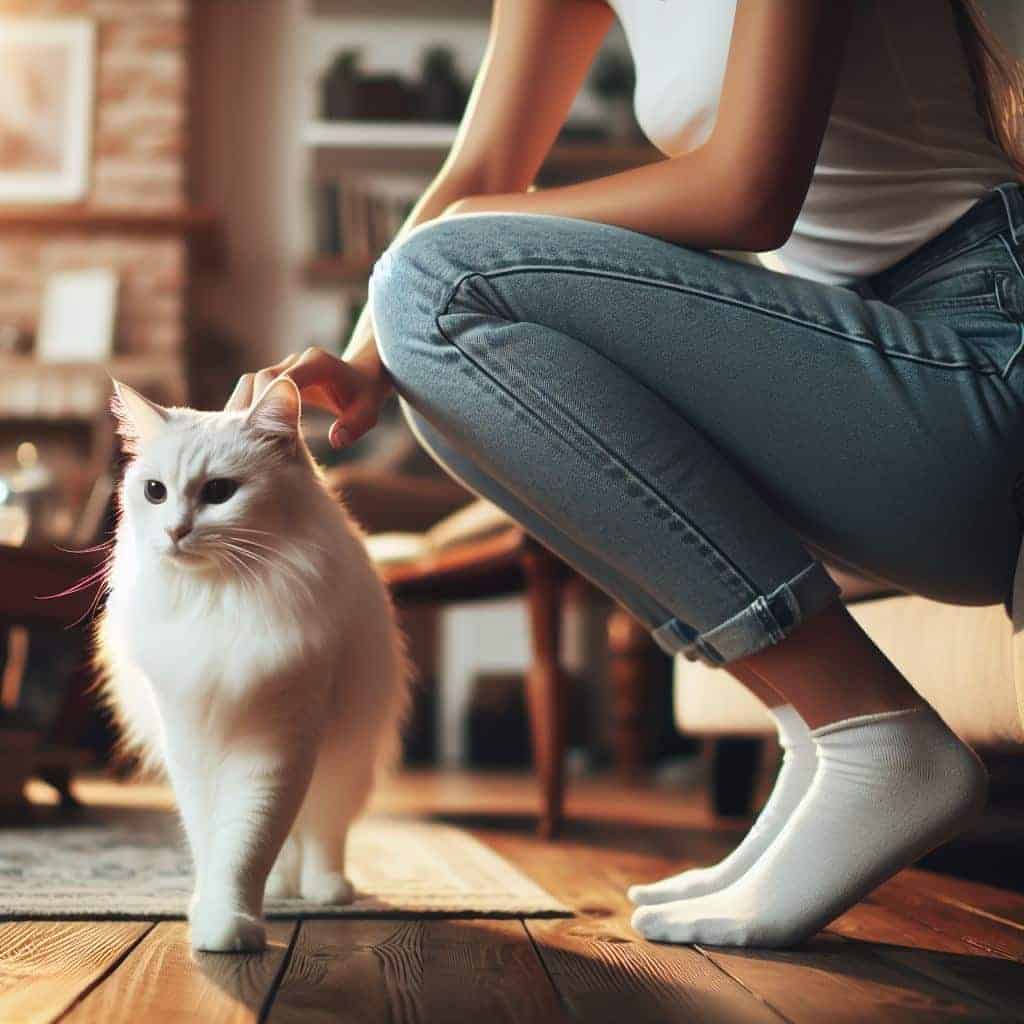
There’s something extraordinary in the way my cat pauses, the tilt of her head, the focus in her eyes when the atmosphere in the room shifts. It’s in these moments I’m compelled to ask: can cats sense fear?
This question isn’t born solely out of curiosity but from countless quiet evenings transformed by the sudden arch of a back or a swift exit under the sofa. As a pet owner, I’ve observed a particular feline sensitivity to emotions, a silent language spoken in the flick of a tail or the soft purring that ebbs and flows with the mood of the room.
The emotional perception in cats is a wondrous dance of instinct and intelligence, one that leaves me in awe and in search of understanding.
In this article, I will provide more insights into the potential for cats to detect human fear through their keen senses and reactions to the emotional state of their owners. 😸
The Science Behind Cats’ Sensory Perception
Understanding Cat Senses
Cats’ sensory abilities are a fascinating aspect of their behavior and communication. Each sense plays a vital role in how cats navigate their surroundings and interact with their environment. By diving into the world of cat senses, we can gain a deeper understanding of our feline companions and ensure their well-being. Let’s explore the intricate realm of cat senses and their significance in the lives of these enigmatic creatures.
Sense |
Function |
|---|---|
| Vision | Helps cats hunt, detect motion, and see in low-light |
| Hearing | Enables cats to localize sounds and communicate vocally |
| Smell | Crucial for detecting scents, pheromones, and emotions |
Vision: The Window to the Cat’s World
Cats’ vision is finely tuned for their predatory nature, offering them advantages in hunting and surveillance. Their eyes contain specialized cells that enhance night vision and motion detection, which are critical for their survival.
Additionally, cats have a broader field of view compared to humans, allowing them to monitor their surroundings efficiently. Understanding how cats see the world through their unique vision provides insights into their behaviors and preferences, guiding us in creating an environment that caters to their visual needs.
Hearing: Tuned In to The Symphony of Sounds
Cats’ ears are remarkable sensory organs that enable them to detect a diverse range of frequencies, including ultrasonic sounds undetectable by humans. This acute hearing aids in hunting and avoiding potential dangers by pinpointing the source of sounds accurately.
Cats also utilize vocalizations and ear movements for communication, expressing various emotions and needs. Acknowledging the importance of sound in cats’ lives enables us to foster better communication with our feline companions and enrich our interactions with them.
Smell: Navigating The Aromatic Landscape
The sense of smell is central to cats’ behaviors and social interactions. Cats rely on their olfactory system to detect scents, pheromones, and emotional cues in their environment. Their keen sense of smell guides them in recognizing familiar scents, marking territories, and communicating with other cats.
Understanding the significance of smell in cats’ sensory world allows us to create enriching experiences that cater to their olfactory preferences, promoting a sense of security and comfort in their surroundings.
Can Cats Really Sense Fear?
Understanding the depth of cats’ sensory perception, particularly their ability to sense fear, is a captivating exploration that unveils the complex nature of feline intuition. By delving into the evolutionary instincts and observational evidence surrounding cats’ responses to fear, we can gain valuable insights into the intricate ways cats navigate the spectrum of emotions.
Aspect |
Influence |
|---|---|
| Instinctual Behavior | Guides responses to potential threats |
| Observational Evidence | Demonstrates cats’ keen awareness of emotions |
Cats’ Instinctual Behavior
Cats’ evolutionary instincts play a significant role in their ability to sense fear and respond to perceived threats. These instincts are deeply ingrained in their survival mechanisms, allowing cats to detect danger and adjust their behavior accordingly. Fear triggers a range of responses in cats, from heightened alertness and defensive postures to seeking refuge in secure spaces. Understanding cats’ instinctual behavior in the context of fear provides insights into their natural tendencies and the ways in which they adapt to challenging situations.
Observational Evidence
Real-life observations and anecdotal evidence offer compelling insights into cats’ remarkable sensitivity to human emotions, including fear. Videos and stories capturing cats’ reactions to fearful situations showcase their keen intuition and emotional intelligence. Cats display behaviors such as seeking comfort from their owners, exhibiting signs of distress in response to alarming stimuli, and adjusting their body language to convey their emotional states. These observations highlight the depth of cats’ perceptiveness and their ability to empathize with the emotions of their human companions.
Factors Influencing Cats’ Perception
Various factors influence cats’ perception of fear, from body language and vocal cues to chemical signals in their environment. Cats rely on visual, auditory, and olfactory cues to interpret and respond to fear-inducing stimuli, showcasing their sophisticated sensory abilities. By considering these factors, cat owners can create a supportive and stress-free environment for their feline friends, fostering a sense of security and well-being. Understanding the intricate interplay between cats’ sensory perception and emotional responses enhances our appreciation for the depth of their emotional intelligence and strengthens the human-cat bond.

Factors Influencing Cats’ Perception
Cats’ sensory perception is influenced by various factors that shape how they experience and respond to the world around them. Understanding these influencers is crucial for cat owners to create an environment that supports their feline companions’ well-being and comfort.
Factor |
Influence |
|---|---|
| Body Language | Signals emotions and intentions |
| Vocal Cues | Conveys communication and emotional states |
| Chemical Signals | Affects behavior through pheromones and scents |
Body Language and Vocal Cues
Cats are adept at interpreting body language and vocal cues, both in their interactions with other cats and with their human counterparts. Subtle changes in posture, tail position, and facial expressions convey a wealth of information about a cat’s emotional state and intentions. Understanding and responding to these non-verbal cues can strengthen the bond between a cat and its owner, fostering trust and effective communication. By observing and respecting a cat’s body language, owners can create a supportive environment that promotes positive interactions and emotional well-being.
Vocalization and Emotional Expression
Cats are vocal creatures that use a variety of sounds to communicate their needs, emotions, and desires. From purrs of contentment to meows of request, each vocalization conveys a distinct message that can provide insight into a cat’s current mood and well-being.
Learning to decipher and respond to a cat’s vocal cues enhances the quality of the human-cat relationship, allowing for better understanding and mutual connection. By listening attentively to their cat’s vocal expressions, owners can address their pets’ needs effectively and strengthen the emotional bond between them.
Chemical Signals and Pheromone Communication
Chemical signals, particularly pheromones, play a significant role in cats’ social interactions and territorial behavior. Cats use scent markings to communicate with other cats, establish territory boundaries, and convey emotional states. Pheromones released through glands on their bodies can influence their behavior and responses to various stimuli.
Understanding the power of chemical signals in feline communication empowers cat owners to create a harmonious environment that supports their cats’ natural instincts and promotes a sense of security and comfort.
By recognizing and respecting the role of pheromones in cats’ communication, owners can enhance their pets’ well-being and strengthen their relationship.
Practical Implications and Tips

Cats’ well-being and behavior are influenced by various practical factors that cat owners can consider to ensure a harmonious living environment for their feline companions.
By recognizing and addressing fear and stress in cats, pet owners can cultivate a sense of security and enhance the bond with their pets.
Let’s go thru the practical implications and effective tips for recognizing, managing, and alleviating fear in cats to improve their emotional well-being.
Implication |
Impact |
|---|---|
| Recognizing Fear Signs | Enables timely intervention |
| Creating Safe Spaces | Provides comfort and security |
| Building Trust and Confidence | Strengthens the human-cat relationship |
Recognizing and Addressing Fear in Cats
Recognizing signs of fear in cats is crucial for understanding their emotional state and addressing their needs appropriately. Common signs of fear in cats include dilated pupils, flattened ears, tail tucked between legs, and increased vigilance. By being attentive to these indicators, cat owners can intervene early to alleviate their cats’ stress and prevent escalating fear reactions. Creating a safe and calm environment is essential for cats to feel secure and overcome their fears, fostering a sense of trust and well-being in the human-cat relationship.
Creating Safe and Secure Environments
Providing cats with safe spaces where they can retreat and feel secure is essential for reducing fear and anxiety. These safe zones can be designated areas equipped with cozy bedding, hiding spots, and calming pheromone diffusers. By offering a sanctuary for their cats, owners promote relaxation and peace of mind, allowing their feline companions to recharge and regroup when feeling overwhelmed. Creating a stress-free environment supports cats’ emotional well-being and strengthens the bond between cats and their owners, nurturing a sense of safety and comfort.
Strengthening the Human-Cat Bond
Building trust and confidence in cats is a gradual process that requires patience, understanding, and positive reinforcement. By engaging in interactive play sessions, providing enriching activities, and offering rewards for desirable behaviors, cat owners can strengthen the bond with their pets and build mutual trust.
Consistent and nurturing interactions create a sense of security and comfort for cats, enhancing their emotional resilience and fostering a harmonious relationship with their human companions. Investing time and effort in strengthening the human-cat bond not only benefits the cats’ well-being but also enriches the lives of both pets and owners.
Myth Busting: Common Misconceptions
By separating truth from speculation, we can better understand cats’ behaviors and emotions, dispelling myths that may cloud our perception of these intelligent and intuitive creatures.
Misconception |
Correct Understanding |
|---|---|
| Cats are Indifferent to Human Emotions | Cats are responsive to human emotions and can sense fear |
| Cats Cannot Detect Fear in Humans | Cats can perceive fear in their owners |
| Cats’ Reactions Are Random and Unpredictable | Cats exhibit purposeful responses to fear-inducing stimuli |
Cats’ Emotional Awareness
One common misconception is that cats are indifferent to human emotions and cannot sense fear. In reality, cats are highly perceptive creatures that can pick up on subtle cues in their owners’ behavior and emotional states. They can empathize with human emotions, including fear, and may exhibit comforting behaviors in response to their owners’ distress.
Understanding cats’ emotional awareness fosters a deeper appreciation for the bond between humans and felines, highlighting the interconnectedness of their emotional lives.
Cats’ Sensory Acuity
Another misconception revolves around cats’ sensory acuity and their supposed inability to detect fear in humans. Cats have finely tuned senses that allow them to pick up on changes in body language, vocal cues, and pheromones associated with fear.
This heightened sensitivity enables cats to respond to fear-inducing stimuli in their environment, whether it stems from external sources or the emotions of their human companions. By acknowledging cats’ sensory capabilities, we can better understand and support their emotional well-being.
Purposeful Responses
Contrary to the belief that cats’ reactions are random and unpredictable, feline responses to fear are often purposeful and intentional. Cats employ a range of behaviors and body language cues to communicate their feelings and respond to perceived threats.
Understanding the nuanced ways in which cats express fear allows us to interpret their responses more accurately and cater to their needs effectively. By debunking myths about cats’ behavior and emotions, we can cultivate a healthier and more informed relationship with these perceptive and enigmatic animals.

Exploring cats’ sensory perception and their ability to sense fear unveils a profound connection between humans and feline companions. Understanding cats’ keen senses of vision, hearing, and smell, alongside their emotional intelligence in perceiving fear, enriches the bond between owners and cats.
By recognizing and addressing fear through body language, vocal cues, and safe environments, we can nurture a trusting and harmonious relationship, fostering mutual understanding and well-being. Embracing cats’ unique abilities and dispelling misconceptions deepens our appreciation for these intuitive creatures, creating a nurturing environment where cats feel valued, secure, and loved.
Helpful Reads
-
- https://www.ncbi.nlm.nih.gov/pmc/articles/PMC7401521/
- https://blog.catbandit.com/can-cats-smell-fear-an-exploration-of-feline-olfactory-abilities/

In her previous life, Lisa traveled extensively, both for work and leisure. After the pandemic struck, Lisa locked up her luggage and adopted a cat ever since.
Lisa is now an avid cat lover, she devotes most of her free time serving as butler to her adorable feline at home. When she is not with her cat, she can be seen using her phone sourcing for the latest cat supplies online.


